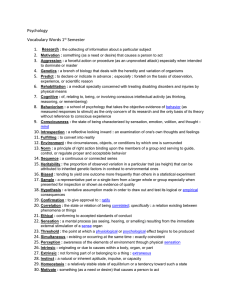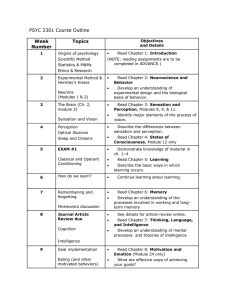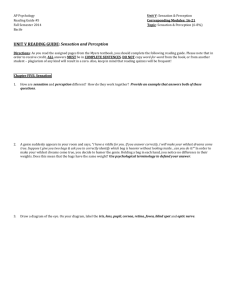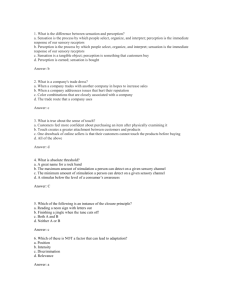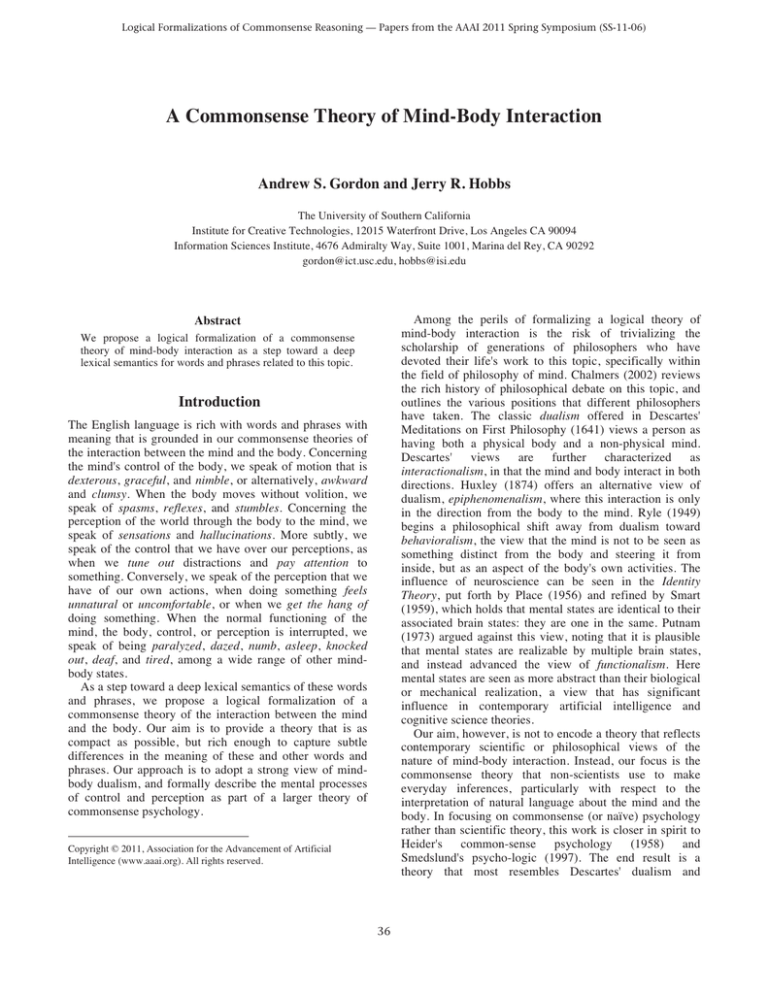
Logical Formalizations of Commonsense Reasoning — Papers from the AAAI 2011 Spring Symposium (SS-11-06)
A Commonsense Theory of Mind-Body Interaction
Andrew S. Gordon and Jerry R. Hobbs
The University of Southern California
Institute for Creative Technologies, 12015 Waterfront Drive, Los Angeles CA 90094
Information Sciences Institute, 4676 Admiralty Way, Suite 1001, Marina del Rey, CA 90292
gordon@ict.usc.edu, hobbs@isi.edu
Among the perils of formalizing a logical theory of
mind-body interaction is the risk of trivializing the
scholarship of generations of philosophers who have
devoted their life's work to this topic, specifically within
the field of philosophy of mind. Chalmers (2002) reviews
the rich history of philosophical debate on this topic, and
outlines the various positions that different philosophers
have taken. The classic dualism offered in Descartes'
Meditations on First Philosophy (1641) views a person as
having both a physical body and a non-physical mind.
Descartes' views are further characterized as
interactionalism, in that the mind and body interact in both
directions. Huxley (1874) offers an alternative view of
dualism, epiphenomenalism, where this interaction is only
in the direction from the body to the mind. Ryle (1949)
begins a philosophical shift away from dualism toward
behavioralism, the view that the mind is not to be seen as
something distinct from the body and steering it from
inside, but as an aspect of the body's own activities. The
influence of neuroscience can be seen in the Identity
Theory, put forth by Place (1956) and refined by Smart
(1959), which holds that mental states are identical to their
associated brain states: they are one in the same. Putnam
(1973) argued against this view, noting that it is plausible
that mental states are realizable by multiple brain states,
and instead advanced the view of functionalism. Here
mental states are seen as more abstract than their biological
or mechanical realization, a view that has significant
influence in contemporary artificial intelligence and
cognitive science theories.
Our aim, however, is not to encode a theory that reflects
contemporary scientific or philosophical views of the
nature of mind-body interaction. Instead, our focus is the
commonsense theory that non-scientists use to make
everyday inferences, particularly with respect to the
interpretation of natural language about the mind and the
body. In focusing on commonsense (or naïve) psychology
rather than scientific theory, this work is closer in spirit to
Heider's common-sense psychology (1958) and
Smedslund's psycho-logic (1997). The end result is a
theory that most resembles Descartes' dualism and
Abstract
We propose a logical formalization of a commonsense
theory of mind-body interaction as a step toward a deep
lexical semantics for words and phrases related to this topic.
Introduction
The English language is rich with words and phrases with
meaning that is grounded in our commonsense theories of
the interaction between the mind and the body. Concerning
the mind's control of the body, we speak of motion that is
dexterous, graceful, and nimble, or alternatively, awkward
and clumsy. When the body moves without volition, we
speak of spasms, reflexes, and stumbles. Concerning the
perception of the world through the body to the mind, we
speak of sensations and hallucinations. More subtly, we
speak of the control that we have over our perceptions, as
when we tune out distractions and pay attention to
something. Conversely, we speak of the perception that we
have of our own actions, when doing something feels
unnatural or uncomfortable, or when we get the hang of
doing something. When the normal functioning of the
mind, the body, control, or perception is interrupted, we
speak of being paralyzed, dazed, numb, asleep, knocked
out, deaf, and tired, among a wide range of other mindbody states.
As a step toward a deep lexical semantics of these words
and phrases, we propose a logical formalization of a
commonsense theory of the interaction between the mind
and the body. Our aim is to provide a theory that is as
compact as possible, but rich enough to capture subtle
differences in the meaning of these and other words and
phrases. Our approach is to adopt a strong view of mindbody dualism, and formally describe the mental processes
of control and perception as part of a larger theory of
commonsense psychology.
Copyright © 2011, Association for the Advancement of Artificial
Intelligence (www.aaai.org). All rights reserved.
36
Figure 1. Mind-Body Interaction
interactionalism, where a physical body and a non-physical
mind interact in both directions.
a physical object, and the mind is not. However, here we
simply note that bodies have some of the same properties
that one might ascribe to other devices, namely that they
are intact, damaged, or destroyed. Given a theory of scales,
these properties could be characterized as high, medium,
and low values on a scale of physical operability.
Similarly, the mind is active, impaired, or inactive, which
can be viewed as analogous values on a scale of nonphysical operability.
A person has a body and a mind.
Overview
The theory of mind-body interaction presented in this
paper postulates that a person has both a mind and a body,
which are connected by the two channels of sensation and
control. The mind, the body, the sensation channel, and the
control channel each have a 3-valued state, namely they are
either active, impaired, disabled, or in the case of the body,
intact, damaged, or destroyed. The control channel
translates the will to do an action with the performance of
the action in the world. The normal sensation channel
operates to translate the stimulation provided by the world
to beliefs in the mind. Figure 1 provides a diagram of the
normal operation of these two channels.
The theory aims to provide an account of action and
perception that is dependent on the status of the mind, the
body, control, and sensation. Under this account, the
mind's perception of the world is a consequence of the
world stimulating the body, and is mitigated by the channel
of sensation. With an intact body, an active mind, and
active sensation, this perception yields beliefs; i.e. seeing is
believing. Likewise, the body's actions are a consequence
of the mind's will, mitigated by the channel of control.
With an active mind, an intact body, and active control,
will yields action.
This theory is presented here in first-order predicate
logic, using the notation of the Common Logic Interchange
Format (ISO/IEC 24707).
(forall (p)
(if (person p)
(exists (b m)
(and (body b p)
(mind m p)))))
(1)
Bodies are intact, damaged, or destroyed.
(forall (b p)
(if (body b p)
(xor (intact b)
(damaged b)
(destroyed b)))))
(2)
Minds are active, impaired, or inactive.
(forall (m p)
(if (mind m p)
(xor (active m)
(impaired m)
(inactive m)))))
(3)
Perception and Sensation
The first channel of interaction between the body and the
mind is that of sensation, where the world's stimulation of
the body (e.g. through sense organs) enables perception.
The predicate stimulate is meant to connote the event
where the world activates the sensory capacity of a person,
e.g. when light hits their eyes, sound vibrates their
eardrums, or objects pass across their skin. Here we use the
predicate eventuality as an abstraction over states and
events of the world, as in Hobbs (1985), and to leave
underspecified the sorts of states and events that can
stimulate the body. A richer theory could distinguish
Mind and Body
We begin by specifying that a person has both a mind and
a body, and that both have a three-valued state that
characterizes their operating potential. We restrict our
discussion to the type person, rather than the more general
agent, so as not to include the wider range of non-human
entities that are typically discussed in formalizations of
agent-based theories, including organizations and
machines. Coupled with a theory of physical objects and
their interaction, we would further specify that the body is
37
between eventualities that are perceptible to people, i.e.
generate sounds loud enough to be heard or reflect enough
light into the eyes. Here we simply note that perception
requires a mind and sensation that are not inactive.
Sensation, subsequently, is the channel by which this
sensory information is passed to the mind. Here we treat
sensation as a relation between this channel, the body, and
the mind. We specify that this channel has three possible
states, using the predicates active, impaired, and inactive to
differentiate high, medium, and low values on a scale of
operability.
Perception
and
misperception
are
differentiated based on the state of this sensation channel,
and on the state of the mind. In either case, perceiving or
misperceiving imply belief (seeing is believing), where the
predicate believe indicates that the person believes the
proposition describing the eventuality.
The world stimulates people's bodies, if they are not
destroyed.
(forall (e b)
(if (stimulate e b)
(and (eventuality e)
(not (destroyed b)))))
(forall (e p b m)
(if (and (misperceive e p)
(eventuality e)
(body b p)
(mind m p)
(sensation s b m))
(or (impaired s)
(impaired m))))
Perception and misperception imply believing.
(forall (e p)
(if (or (perceive e p)
(misperceive e p))
(believe e p)))
The second channel of interaction between the body and
the mind is that of control, where a person's will to act
leads to bodily action, mitigated by their level of control.
The predicate bodyAction is used here to connote the sorts
of things that bodies can do, and insomuch as those bodies
are bodies of people, then they are actions of people as
well. Here action is used in its standard meaning (e.g.
Davis & Morgenstern, 2005). However, some care must be
made in the further interpretation of bodyAction. Here,
bodily actions are meant to indicate some muscular
exertion, as when someone clenches their fist to squeeze a
sponge. However, this action may not result in motion of
the hand, e.g. if instead one tries to squeeze a rock. In this
theory, the bodily action (squeezing the rock) occurs in
accordance with a person's will even if the intended result
of the action (crushing a rock) fails to occur.
Like sensation, the channel of control can be in three
states: active, impaired, and inactive. Bodily actions are
initiated when a person wills them to occur. We use the
predicate will as a relation between a person and an action
that holds when the mind executes intended action.
Accordingly, it is will that distinguishes an intended body
action from an unintended body action. A special type of
unintended bodily action is elaborated, a reflex, where
stimulation of the body is viewed as the cause. We use the
dcause predicate to indicate that the eventuality of the
stimulation is the direct cause of the bodily action, as in
Hobbs & Gordon (2005).
Body actions are actions of people.
(4)
(5)
Sensation from the body to the mind is active, impaired,
or inactive.
(forall (s b m)
(if (sensation s b m)
(xor (active s)
(impaired s)
(inactive s))))
(6)
Perception of an eventuality implies stimulation of the
body, sensation that is not inactive, and a mind that is not
inactive.
(forall (e p b m)
(if (and (perceive e p)
(eventuality e)
(body b p)
(mind m p)
(sensation s b m))
(and (stimulate e b)
(not (inactive s))
(not (inactive m)))))
(9)
Action and Control
Sensation is a channel between the body and the mind of
a person.
(forall (p)
(if (and (person p)
(body b p)
(mind m p))
(exists (s)
(sensation s b m))))
(8)
(7)
(forall (a b p)
(if (and (bodyAction a b)
(body b p))
(action a p)))
(10)
Body actions may be intended or unintended.
Misperception implies impaired sensation or an impaired
mind.
(forall (a b)
(if (bodyAction a b)
(xor (intended a)
(unintended a))))
Body actions imply bodies that are not destroyed.
38
(11)
(forall (a b)
(if (bodyAction a b)
(not (destroyed b))))
predicates of enable and prevent within a first-order
framework, it is necessary to reify the eventuality of the
stimulation, the tuning in, and the tuning out. Here we
adopt the style of ontological promiscuity proposed by
Hobbs (1985), creating new primed predicates (stimulate',
tuneIn', tuneOut') where the unprimed versions are true
exactly in the case that the eventuality (the first argument
of each predicate) really exists. Enable and prevent take
their standard meanings within a theory of causality, e.g. as
causally involved in the causal-complex that produces the
effect (Hobbs, 2005).
The action of "tuning in" to something is a body action
that enables stimulation.
(12)
Control is a channel between the mind and the body of a
person.
(forall (p)
(if (and (person p)
(body b p)
(mind m p))
(exists (c)
(control c m b))))
(13)
The mind's control of the body is active, impaired, or
inactive.
(forall (c m b)
(if (control c m b)
(xor (active c)
(impaired c)
(inactive c))))
(forall (e p b e1 e2)
(if (and (tuneIn' e1 e p)
(stimulate' e2 e b)
(body b p))
(and (bodyAction e1 b)
(enable e1 e2))))
(14)
The action of "tuning out" something is a body action
that prevents stimulation.
Intended actions imply will and active control.
(forall (a b c m p)
(if (and (bodyAction a b)
(intended a)
(control c m b)
(body b p))
(and (will a p)
(active c))))
(15)
(forall (e p b e1 e2)
(if (and (tuneOut' e1 e p)
(stimulate' e2 e b)
(body b p))
(and (bodyAction e1 b)
(prevent e1 e2))))
Unintended actions imply no will.
(forall (a b p)
(if (and (bodyAction a b)
(unintended a)
(body b p))
(not (will a p))))
(19)
Sensation of Action
(16)
Kinesthesic sense enables awareness of the position and
movement of parts of the body by means of proprioceptors
in the muscles and joints. Our theory allows us to simply
model this sense in terms of bodily actions that are
themselves the eventualities that stimulate the body. The
predicate stimulating is used here to indicate body actions
that have this property. The resulting perception of action
that follows can be characterized in several ways, e.g. as
dexterous, awkward, uncomfortable, fluent, etc.
Sometimes, people just feel that a bodily action "feels
weird." Here we present a simple formulation of fluent and
awkward bodily actions, distinguished by the state of the
control and sensation channels.
Some body actions stimulate the body, while other do
not.
Reflexes are unintended body actions caused by
something that stimulates the body.
(forall (a b)
(if (reflex a b))
(and (bodyAction a b)
(unintended a)
(exists (e)
(and (stimulate e b)
(dcause e a))))))
(18)
(17)
(forall (a b)
(if (bodyAction a b)
(xor (stimulating a)
(nonstimulating a))))
Control of Perception
Not completely independent, sometimes the control
channel can influence the sensation channel. A person can
listen intently to a distant conversation or track a moving
object with their eyes. Likewise, a person can try to ignore
a pain, avert their eyes, or shut out an annoying sound. We
model all control of this sort as "tuning" in or out an
eventuality of the world, enabling or preventing it from
stimulating the body. To correctly notate the causal
(20)
Body actions seem fluent to people when they are
stimulating and where both sensation and control are
active.
39
(forall (a p b m)
(if (and (fluent a p)
(body b p)
(mind m p)
(control c m b)
(sensation s b m))
(and (stimulating a)
(active c)
(active s))))
to formulate that the body is composed of body parts, some
of which are sense organs, and to assign senses of touch,
taste, smell, hearing, and sight as appropriate. Such an
extension would also improve inferences about damage to
the body, e.g. how damage to sense organs might affect the
sensory modalities.
(21)
State
Body Mind Control Sensation
Fine
+
+
+
+
Sore
/
+
+
+
Wounded
/
+
+
+
Tired
+
/
/
+
Numb
+
+
+
Blind/deaf
+
+
+
Tingly
+
+
+
/
Paralyzed
+
+
Dazed
+
/
+
+
Schizophrenic
+
/
+
/
Drunk
+
/
/
/
Dreaming
+
/
/
Sleeping
+
/
Unconscious
+
Brain dead
/
Dead
Table 1. Mind-body states (+ active or intact, / impaired or
damaged, - inactive or destroyed)
Likewise, actions seem awkward to people when those
actions are stimulating body actions and either sensation or
control are impaired.
(forall (a p b m)
(if (and (awkward a p)
(body b p)
(mind m p)
(control c m b)
(sensation s b m))
(and (stimulating a)
(or (impaired c)
(impaired s)))))
(22)
Mind-Body States
The axioms in the previous sections postulate the
separation of the mind and the body, and identify the
channels of control and sensation between them. Each of
these four components is given a three-valued state. The
mind, control, and sensation can be active, impaired, or
inactive, and the body can be intact, damaged, or
destroyed. Different combinations of these possible values
each yield different mind-body states, each with their own
set of inferred consequences.
For example, we can define the mind-body state of
unconscious as the state where the body is intact, but the
mind, control, and sensation are inactive.
(forall (p m b)
(if (and (unconscious p)
(mind m p)
(body b p)
(control c m b)
(sensation s b m))
(and (intact b)
(inactive m)
(inactive c)
(inactive s))))
Discussion
In many respects, the theory of mind-body interaction
presented in this paper is more complicated than previous
formalizations of action or perception. For example, Davis'
high-level theories of visual perception (1988) and handeye coordination (1989) are extremely compact,
introducing only a handful of new predicates to articulate
key axioms. In contrast, this paper offers nearly two-dozen
axioms with more than two-dozen new predicates, none
that are suitably defined. Also lacking any presentation of
provable theorems, our theory fails to meet several of the
criteria that have traditionally been used to assess
formalizations of content theories.
Instead, our work is motivated by a need for a deeper
lexical semantics for natural language (Hobbs, 2008),
where the logical formalizations are themselves rich
enough to characterize differences in meaning at varying
degrees of subtlety. With this aim in mind, the theory
presented in this paper is elegant insomuch as it affords
distinctions in meaning, e.g. between dexterous action and
reflexes, or between sleeping and unconscious.
By this criterion, however, there remain many aspects of
the theory that need improvement. First, our treatment of
perception (through sensation) fails to distinguish between
sensory modalities, or recognize that sensations have
degrees of clarity. As a consequence, the theory cannot
distinguish between seeing clearly and faintly hearing. The
theory also lacks any treatment of the subjective types of
sensations, e.g. the concept of pain.
(23)
With analogous axioms, a wide variety of mind-body
states can be easily interpreted as variations of these three
values for these four components. Table 1 lists several of
these mind-body states with their corresponding properties.
Table 1 also serves to highlight some of the weaknesses
of the theory as presented in this paper. Here, the states of
being numb, blind, and deaf have identical properties, each
with good condition of body, mind, and control, but
inactive sensation. The solution to this problem, which
would serve as the basis for an improved theory, would be
40
Second, our treatment of bodily actions does not
distinguish those that cause motion, nor does it explore
how different body parts move separately in coordinated
action. As a consequence, the theory cannot distinguish
between clumsy and graceful, nor draw inferences about
hand-eye coordination or lack thereof.
Third, our treatment of control of perception is only at a
very high level (tuning in and out), and fails to distinguish
between the ways in which this the mind controls different
sensory modalities. For example, the eye tracks moving
objects, focuses on distant and close objects, closes before
sleeping, but blinks while awake. The theory provides no
insight into which types of sensations can be easily tuned
out, e.g. that people might find it easy to tune out the
gentle sound of rain while reading a book, but not loud
conversations.
Fourth, our treatment of the perception of action would
also benefit from elaboration of the subjective types of
sensations created by body actions. This would enable
richer interpretations of language related to ergonomics,
e.g. distinguishing painful from natural body motions, or
of comfortable grips on handles and handholds.
Fifth, as mentioned earlier, the theory fails to distinguish
between certain mind-body states. The differences between
deaf, blind, and numb require (at least) distinctions in
sensory modalities. This would also improve the
interpretation of states such as sleeping, and how you can
be woken up by a loud noise, but not a horrific photograph.
Despite all of these weaknesses, the theory presented
here moves us toward a deeper lexical semantics for the
language of mind-body interaction, more so than any
previous formalization effort. Our approach was to adopt a
strong view of mind-body dualism, following the original
two-way interactionalism of Descartes Meditations.
Alternative formulations of the same content, but based on
different philosophical perspectives, are certainly possible.
As extensions and alternative theories are put forth, it will
be necessary to consider the criteria by which content
theories such as this are to be evaluated and compared.
Ultimately, theories of this sort should be evaluated by
both breadth and depth, i.e. by their capacity to encode the
meaning of natural language words and phrases
(coverage), and their ability to generate correct inferences
based on these encodings (competency).
References
Chalmers, D. (2002) Foundations. In D. Chalmers, ed.,
Philosophy of Mind: Classical and contemporary readings.
New York: Oxford University Press, pp. 1-9.
Davis, E. (1988) Inferring ignorance from the locality of
visual perception. Proceedings of AAAI 1988, pp. 786790.
Davis, E. (1989) Reasoning about Hand-Eye Coordination.
IJCAI-89 Workshop on Knowledge, Perception, and
Planning.
Davis, E. & Morgenstern, L. (2005). A First-Order Theory
of Communication and Multi-Agent Plans. Journal of
Logic and Computation, 15(5):701-749.
Descartes, R. (1641/1985) Meditations on First Philosphy.
In J. Cottingham, ed./trans., Meditations on First
Philosophy. Cambridge University Press.
Heider, F. (1958) The psychology of interpersonal
relations. Hillsdale, NJ: Lawrence Erlbaum Associates.
Hobbs, J. (1985) Ontological promiscuity. Proceedings of
the 23rd Annual Meeting of the Association for
Computational Linguistics, Chicago, Illinois: 61-69.
Hobbs, J. (2005) Toward a useful concept of causality for
lexical semantics. Journal of Semantics, 22: 181-209.
Hobbs, J. (2008) Deep Lexical Semantics. Proceedings of
the 9th International Conference on Intelligent Text
Processing and Computational Linguistics (CICLing2008), Haifa, Israel.
Hobbs, J. and Gordon, A. (2005) Encoding Knowledge of
Commonsense Psychology. 7th International Symposium
on Logical Formalizations of Commonsense Reasoning.
May 22-24, 2005, Corfu, Greece.
Huxley, T. (1874) On the hypothesis that animals are
automata, and its history. Fortnightly Review 16:555-80.
Place, U. (1956) Is consciousness a brain process? British
Journal of Psychology 47:44-50.
Putnam, H. (1973) The nature of mental states. In W.
Capitan & D. Merril, eds., Art, mind, and religion.
University of Pittsburgh Press, pp. 37-48.
Acknowledgments
Ryle, G. (1949) Descartes' Myth. In G. Ryle, The concept
of mind. Hutchinson and Co., pp. 11-24.
The project or effort described here has been sponsored by
the U.S. Army Research, Development, and Engineering
Command (RDECOM). Statements and opinions expressed
do not necessarily reflect the position or the policy of the
United States Government, and no official endorsement
should be inferred.
Smart, J. (1959) Sensations and
Philosophical Review 68:141-56.
brain
processes.
Smedslund, J. (1997) The structure of psychological
common sense. Hillsdale, NJ: Lawrence Erlbaum
Associates.
41





